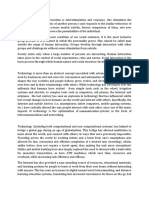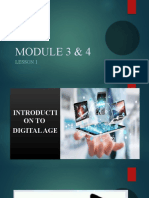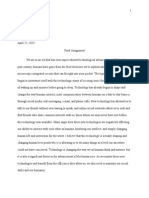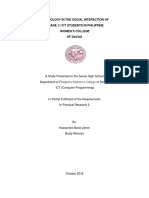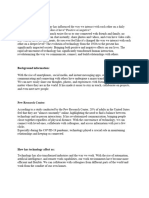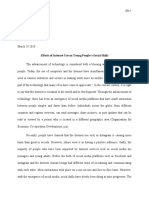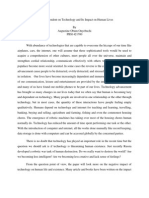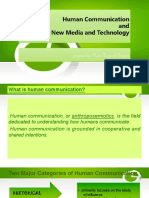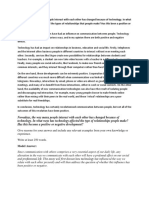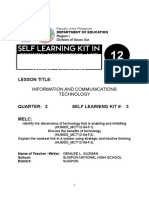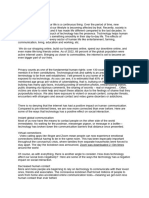Republic of the Philippines
ZAMBOANGA PENINSULA POLYTECHNIC STATE UNIVERSITY
Region IX, Zamboanga Peninsula
R.T. Lim Blvd., Zamboanga City
GE 117 Course Pack
Date Document No. ZPPSU –
GE 117 Developed: LM2020
CODE 08-31-2021 Issued by: APPROVED
ZPPSU-DME
Date Revised:
Science, Technology 08-31-2021
and Society Prepared by:
COURSE TITLE ENGR. EMELYN K. ABAO
ROSALIE R. BAGUIO
1|Page
� VISION MISSION INSTITUTIONAL CORE VALUES
ZPPSU as the leading provider of Provide effective and OUTCOMES Love of God;
globally competitive human efficient services through Globally competitive Social Responsibility;
resources. advance technological graduates who can perform Commitment/
studies and researches for advanced Dedication to the
the empowerment of the technological competencies Service; and
nation’s human resources. in their field of specialization. Accountability
FOCUS LESSON / IMPORTANT CONCEPT
1. The Effects of Technology on Human Interaction
2. The Positive Effect
3. Faster and Ease of Communication
4. The Negative Effect
5. The End of Intimacy
6. Defining Human Interaction
7. Changing the Rules of Human Interaction
8. Virtual Distance and the Growing Child
9. How is Virtual Distance Affecting Human Relations?
10. When Connectivity Really Means Disconnection
LEARNING OUTCOMES:
The students will be able to:
1. Examine human rights in order to uphold such rights in technological
Ethical dilemmas.
______________________________________________________________________________
2|Page
� Module 5
When Technology and Humanity Cross
_________________________________________
The Effects of Technology on Human Interaction
Technology is more than an abstract concept associated with
advanced tools and systems used by businesses and end-users for
convenience and automation of complex tasks. It also shapes the way
societies and people behave, grow, evolve, and develop, both within their
own lives and in their relationships with others. While technology has
developed over the millennia that humans have existed - from simple
tools such as the wheel, irrigation systems and chariots, to complex tools
such as computers, cell phones, the Internet and airplanes - the last
century has seen an explosion in technology that has influenced subtle
but crucial changes in how humans see the world and interact with
others. Specifically, the Internet and mobile devices (i.e. smartphones,
tablet computers, mobile gaming systems, etc.) have radically altered the
way people interact with each other, since one of the major impacts of
technology is the optimization of communication systems in the form of
telecommunications and networking. While the Personal Computer and
other electronics affected human interaction, they arguably did not have
such critical impacts on human sociology until mobile computers came
about. Mobile devices brought groundbreaking change to human
interaction due to the innate nature of always being connected to the
digital world via an easy-to-carry device that one carries around.
The very nature of all technological systems has altered human
behaviors and interactions in some negative ways, but has also created
unprecedented opportunities for modifying human behaviors in positive
ways.
3|Page
� Computer systems and the Internet have altered human interactions
arguably in the most critical ways when compared to non-computer
technological systems that have been developed in the last few centuries.
The alterations in how humans communicate with each other in the
modern day - which is largely via smart apps, through the Internet/WiFi -
has both good and bad consequences. The wide availability of Internet-
capable smart devices means that it is now possible for loved-ones to be
in close contact wherever they are on earth (assuming that WiFi is
available). The advent of VOIP also allows near-instant communication via
the Internet even when cellular service is unavailable. It is easier now than
ever for people to stay closer (digitally) to their loved ones when they are
physically far apart. Skype, FaceTime, Facebook Messenger Calls, Viber
Calls, and WhatsApp calls all give people robust capabilities to utilize the
Internet as a platform for global communication. This also translates into
the business world where it is not uncommon for global companies to
interview clients or prospective personnel using VOIP and messaging
apps. Additionally, social media, forums, and the interactive Web 2.0 allow
people from all over the world to connect, meet, learn, and grow together
over a digital medium. Technology has even transformed certain common
behaviors associated with learning about the world and connecting with
people around the world. Pen pals, for instance, have largely been
replaced with “key pals,” and instead of people going to language centers
to learn a language, people often turn to YouTube or podcasts to learn
about other cultures and languages.
The effects are not all positive, however. While technology has helped
to bridge a global gap by connecting people via the digital world, those
who are physically close together are often far apart due to their inability
to separate themselves from their mobile devices. This is called Virtual
Distance. Additionally, modern Technology is often linked to an over
exposure to EMFs, and is linked to excessive blue light exposure, while
4|Page
� developing children not only face possible cognitive changes due to
constant exposure to the above factors, but often grow up in a possibly
more isolated manner due to constantly being “wired” to their smart
devices instead of physically spending time with friends.
The Positive Effect
Technology (including both computational and non-computational
systems) has helped to bridge a global gap during an age of globalization.
This bridge has allowed multitudes to learn about the world, and connect
with others, in ways that were previously impossible. Traveling across the
world by booking tickets and a hotel from one’s smartphone also allowed for
fast, convenient and efficient completion of a desired task (traveling), which,
unlike before, does not require a travel agent, thus making the task more
streamlined. Online and mobile banking have also largely replaced the need
to interact with a bank teller for monetary transactions, as have ATM
machines, which save time, resources and overhead, while increasing task
efficiency and efficacy.
The Internet has also provided a near unending source of resources,
educational materials, and learning systems for people to learn or work from
their own home, without interacting with anyone. This has seen an increase
in digital nomad word/telecommuting, and distance learning education
systems, translating into increased convenience for those on-the-go, but
also often has the unintended consequence of students, workers, adults and
children losing their social skills due to being increasingly isolated from
others.
Additionally, for social interactions, people often meet friends or dates
using apps, from the convenience and comfort of their own home. This is
contrasted with a previous age of meeting friends and dates via day-to-day
mingling outside of one’s own home. The downside to this is a possible
5|Page
�prevalence of antisocial behavior and lack of social skill development,
where, instead of meeting people in the outside world, some youth are only
able to communicate by texting via messaging or dating apps.
Faster and Ease of Communication
Communication, transportation, and interactions with others are faster
than ever before, with the advent of airplanes, trains, buses, cars, and
computer/mobile messaging and social media apps. Not only are such
complex tasks faster, they are often more efficient. In antiquity, it would
have taken months, if not years, to travel from one end of the globe to
another, or to even make contact with someone from the other side of the
world. Today, those tasks can be completed in a day, or within minutes,
making living in the modern world much easier and more efficient. For those
with a busy lifestyle and for businesses, “time is money,” so saving time and
increasing task efficiency is critical.
The Negative Effect
Technology has both eliminated a gap and created one. Virtual
distance is the phenomenon where people are physically together but
detached from each other due to being completely absorbed with their
technological device,
such as a laptop or smartphone/tablet (mobile device). This translates to
couples, parents and children, and all types of other human interactions
being relegated to the background while people are busy connecting with
others in digital space via their technological device.
The End of Intimacy
6|Page
� It is not uncommon for people to prefer texting instead of actually
meeting, or at the very least, calling and thus hearing another human voice.
It is also not uncommon for people to walk around, or even sit with others,
head bowed to their digital device without saying a word or even noticing
anything about anyone else. Human interactions and relationships have thus
largely decreased, while intimacy and human-to-human interactions have
been replaced with human-to-machine interactions. Technology has helped
to modify human behavior by creating a gap between people and reducing
intimacy. In an age where robots and AI are slowly replacing humans within
the workplace, this interaction between humans and machines is only set to
increase.
Defining Human Interaction
Human interaction can be defined as any action that is taken between
two humans, for better or for worse. Sociology is the study of human
interactions and relationships, with relation to societies and cultures.
Changing the Rules of Human Interaction
As a globalized world increases the intertwining of societies and cultures
- often via technology such as social media and the Internet - many cultures
are absorbed by an ever-increasing culture that is heavily reliant upon
technology. While telephones, for instance, have existed for many decades,
messaging apps and mobile devices have allowed people to adopt brand
new behavioral mechanisms that allow for more convenience and
streamlined completion of tasks, with the trade-off being reduced human-to-
human interactions. For example, it is not uncommon for expats in foreign
countries to defer learning the local language, and to use Google Translate
and other translation software for communication, which often results in
misunderstandings and the creation of a digital wall between the two
parties. Technology now serves as a medium for human interactions, which
7|Page
�(in the case of computer technology) only increases human-to-machine
interactions.
Virtual Distance and the Growing Child
As noted above, the phenomenon of Virtual Distance affects every
human on Earth utilizing mobile technology, but is particularly destructive to
growing children. Behaviors are rooted in the brain, and due to
neuroplasticity and epigenetics, cognitive development also sees the
development of psychological factors and human behaviors as a child’s brain
“responds” to environmental cues and the behaviors of others. Children
learn from observing and interacting with their parents and peers, but their
cognitive and psychological development can be hindered, and certain social
skills lost or delayed, when they are disconnected from others and
overexposed to technology. Reduced human-to-human interactions and
increased human-to-machine interactions has the potential to greatly
obstruct normal development among children who need healthy human
interactions to grow.
The phenomenon of virtual distance also harms the serve and return
interaction that shapes brain architecture and neural connections. This
interaction is an action-reaction based sociological mechanism where, for
instance, a child or infant cries, which should result in a cascade of
responses from a parent or other adult. As noted by Harvard, “when an
infant or young child babbles, gestures, or cries, and an adult respond
appropriately with eye contact, words, or a hug, neural connections are built
and strengthened in the child’s brain that support the development of
communication and social skills. Much like a lively game of tennis, volleyball,
or Ping-Pong, this back-and-forth is both fun and capacity-building. When
caregivers are sensitive and responsive to a young child’s signals and needs,
they provide an environment rich in serve and return experiences.” (“Serve
and Return”). This response can also help to build a child’s empathy and
8|Page
�compassion when their own needs are met in an empathetic manner
(usually from a parent). This is critical as it is noted that an overuse of
technology has often resulted in a lack of empathy among some, who are so
disconnected that they are unwilling to engage in helping behaviors.
How is Virtual Distance Affecting Human Relations?
Virtual distance has created a gap between a myriad of types of human
relationships, including:
Couples: It is not uncommon for couples to spend less and less time
actually talking with each other, and more time glued to their mobile
devices or TV sets.
Teachers and Students: The advent of tablets, apps and computer
devices has seen schools using mobile devices and internet gateways
for assignments and learning
Parents and Children: Often, tablets raise children more than parents
do, while a parent’s inability to directly engage with their children
often results in disconnected children who have not developed the
correct social skills to engage with others in a healthy manner.
Co-workers: With a modern increase in technology that serves to
automate tasks and replace certain non-technological systems,
personnel often do not have to interact with other workers as much as
before, but often interact more with computer systems. This is even
more of an issue with telecommuting and digital nomad work. This
often results in a lack of enthusiasm for work and/or a lack of
commitment to projects, along with miscommunication and
misunderstandings.
One of the main areas of interaction that has been impacted by Virtual
Distance and technology besides parenting is dating. With the advent of
9|Page
�popular dating apps like Tinder, people do not utilize social skills to meet
potential mates, but simply swipe through a “catalog” of people.
Additionally, ghosting (simply disappearing from the digital world when one
is no longer interested) is often very prevalent, which results from a lack of
social skills - or courage - to end a relationship in the old fashioned way.
Thus, virtual distance directly results in the reduction of refined social skills
that was previously universal.
When Connectivity Really Means Disconnection
Though technology has helped to bridge global gaps, devices and
social media/messaging apps, for instance, have largely helped to create a
larger disconnect between people. Increased isolation, reduced social
interaction and social skills, and increased human-to-machine interactions
are all a result of an overuse of technology, which has created a wall
between many people globally. Instead of physically experiencing the
emotions of another, most people who solely utilize technology for
interactions rely on emoticons, for instance. And instead of meeting
physically, many people opt to chat via text over the Internet. When
meetings do occur, social interactions are often reduced and relegated to
chats in between being glued to one’s mobile device.
In the modern day, many people live in the digital world more than the
real world. This has often resulted in a myriad of shallow relationships, and a
great reduction in intimacy which directly affects the way people operate,
the values and expectations people have, and the way people think about
others. Technology has shaped the way children see and interact with others
and with the world, which greatly affects their development.
But technology does have the ability to bridge gaps when used correctly. It
has greatly improved communication worldwide, has increased the efficiency of
transportation and other personal and business tasks, and thus has given people all
10 | P a g e
�over the world the opportunity to engage with others in a powerful, albeit, different
way (Wardynski, DJ, 2019).
ABSTRACTION
In contemporary world different technological advancements in all
forms are found in different areas of our lives. Technology is available to all.
It is evident since almost everyone owns at least one technological device.
Technology need not to be high-priced and high-end gadget.
Technology can be simple kind of machine that help man do work. In
spite of its worth and valuable features there are still predicaments
encountered by different technological advancements. These predicaments
are principled that involve machine and mankind. Technology now become a
necessity for man. At the end, moral principles should still be implemented
in the field of technology so as to ensure the security and integrity of the
gadget to people.
______________________________________________________________________________
MID TERM EXAMINATION
_________________________________________
11 | P a g e

